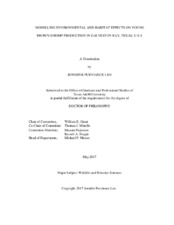| dc.description.abstract | Brown shrimp (Farfantepenaeus aztecus) support a commercially important fishery in the northern Gulf of Mexico, and juveniles use coastal estuaries as nurseries. Production of young shrimp from any given bay system, and hence commercial harvest of sub-adults and adults from the Gulf, is highly variable from year to year. We describe development of a spatially-explicit, individual-based model representing the cumulative effects of temperature, salinity, and access to emergent marsh vegetation on the growth and survival of young brown shrimp, and we use the model to simulate shrimp production from Galveston Bay, Texas, U.S.A. under environmental conditions representative of those observed from 1983 to 2012. We also describe a field growth study conducted from April 12 to June 9, 2011, designed to validate and improve the model.
The model reproduced biomass and size distribution patterns observed in field data. Although annual variability of modeled shrimp production did not correlate well (R2 = 0.005) with fisheries independent trawl data from Galveston Bay, there was a significant correlation with similar trawl data collected in the northern Gulf of Mexico (R^2 = 0.40 p = 0.0005). Identifying and representing spatially variable factors such as annual recruitment timing and magnitude among bays, therefore, may be the key to understanding bay-specific contributions to the adult stock. In our field growth study, we used a mark-recapture approach to measure brown shrimp growth in three polyhaline marsh ponds over periods of two to four weeks. We recorded hourly temperature and flooding data, and also measured biomass of infaunal food organisms. We parameterized our production model with input from 2011 to compare modeled output to observed data. Mean growth rate estimates from the model were similar to the estimated mean growth rate observed in the field (1.13 mm d-1, 1.06 mm d-1, respectively), however, growth rates differed significantly between marsh ponds. Data on infaunal biomass suggest that spatial and temporal variability in available food organisms is related to differences in growth, and the inclusion of such information may enhance the model. | en |


